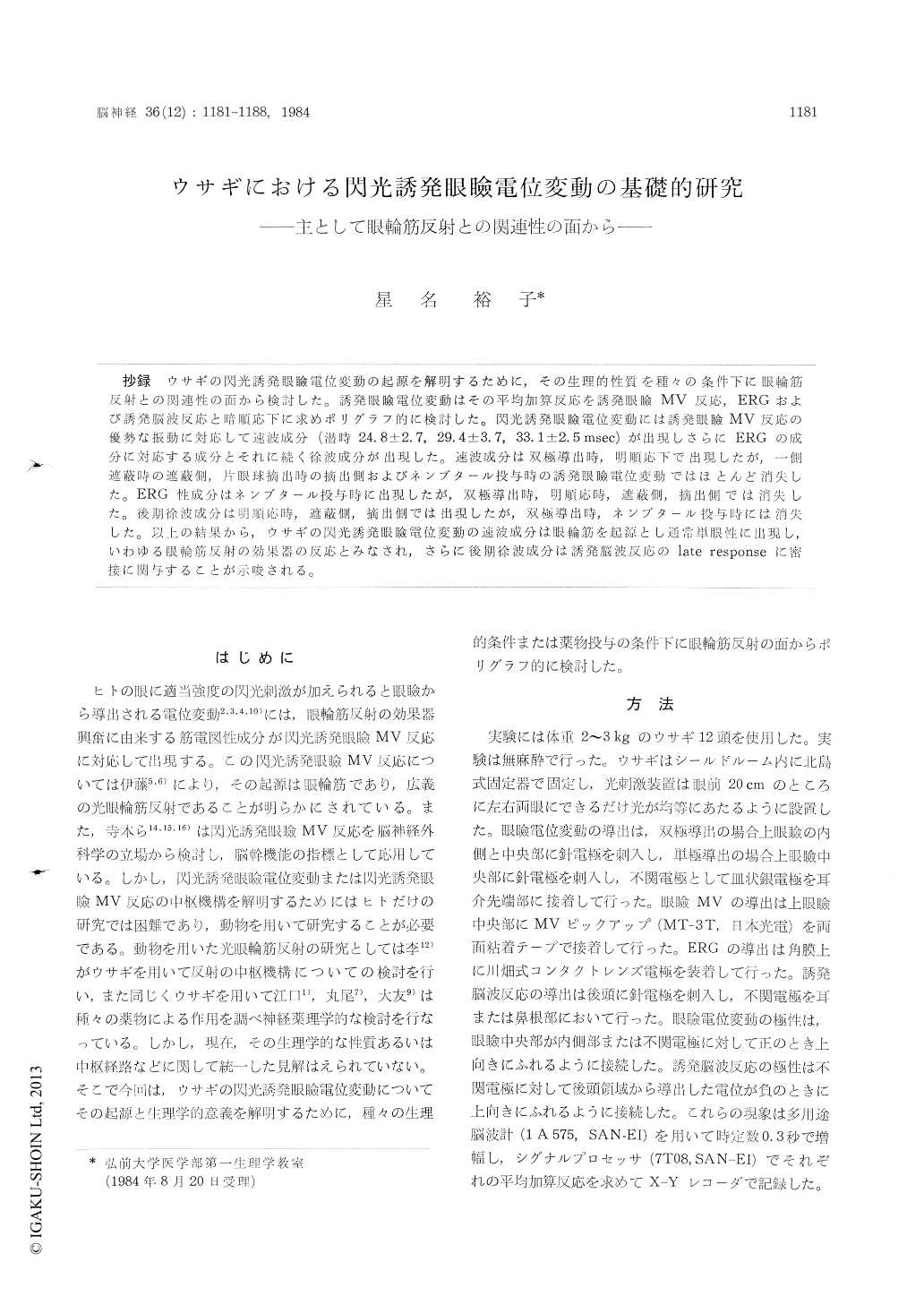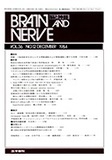Japanese
English
- 有料閲覧
- Abstract 文献概要
- 1ページ目 Look Inside
抄録 ウサギの閃光誘発眼瞼電位変動の起源を解明するために,その生理的性質を種々の条件下に眼輪筋反射との関連性の面から検討した。誘発眼瞼電位変動はその平均加算反応を誘発眼瞼MV反応,ERGおよび誘発脳波反応と暗順応下に求めポリグラフ的に検討した。閃光誘発眼瞼電位変動には誘発眼瞼MV反応の優勢な振動に対応して速波成分(潜時24.8±2.7,29.4±3.7,33.1±2.5msec)が出現しさらにERGの成分に対応する成分とそれに続く徐波成分が出現した。速波成分は双極導出時,明順応下で出現したが,一側遮蔽時の遮蔽側,片眼球摘出時の摘出側およびネンブタール投与時の誘発眼瞼電位変動ではほとんど消失した。ERG性成分はネンブタール投与時に出現したが,双極導出時,明順応時,遮蔽側,摘出側では消失した。後期徐波成分は明順応時,遮蔽側,摘出側では出現したが,双極導出時,ネンブタール投与時には消失した。以上の結果から,ウサギの閃光誘発眼瞼竜位変動の速波成分は眼輪筋を起源とし通常単眼性に出現し,いわゆる眼輪筋反射の効果器の反応とみなされ,さらに後期徐波成分は誘発脳波反応のlate responseに密接に関与することが示唆される。
In order to elucidate the origins of the poten-tial changes in the eyelid elicited by flash stimu-lation in rabbits, their physiological properties were studied under various conditions. In the present study, they were specially discussed from the standpoint of orbicularis oculi reflex.
The photically evoked lid potential changes were obtained with the summation technique by the signal processor (7 T 08, SAN-El, Tokyo). In addition, the average summated responses of pho-tically evoked lid MV responses, electroretinogram (ERG) and the electroencephalogram (EEG) were recorded simultaneously under dark-adapted condi-tions and studied polygraphically.
The results obtained were as follows:
1) The average photically evoked lid potential changes in rabbits were shown to be composed of early rapid and slow components and late slow component. The early rapid and slow components corresponded to dominant vibrations of the evoked lid MV responses and the a and b waves with oscillatory potential of the ERG. The early rapid components, which corresponded to dominant vib-rations of the evoked lid MV responses, consist of positive, negative and positive components with peak latencies of 24.8±2.7, 29.4±3. 7 and 33.1±2.5 msec, respectively.
2) In the average lid potential changes led off bipolarly from medial and middle parts of the su-perior lid, the electromyographic components ap-peared corresponding to the evoked lid MV re-sponses, although the electroretinographic compo-nents and late slow component were observed to decreased considerably in amplitude or disappeared almost completely, as compared with those ob-tained by monopolar leads.
3) In the average lid potential changes obtained by flash stimulation to a single eye, the electro-retinographic and electromyographic components disappeared almost completely in the occluded side. The dominant components of the evoked lid MVresponses disappeared almost completly according to the disappearence of the electromyographic components of the lid potential changes. The late slow component of the lid potential changes was, on the other hand, observed to appear though it was decreased in amplitude.
4) In well light-adapted eyes, the electroretino-graphic components were observed to be decreased considerably or not seen clearly, while the late slow component appeared. On the other hand, the electroretinographic and the late slow components appeared in dark-adapted eyes after switching off the light in the dark, electromagnetically shielded room.
5) In the rabbits with unilateral anophthalmos, the electromyographic components and electrore-tinographic components almost disappeared but the late slow component of the lid potential chan-ges appeared in extirpated side. The late slow component of the lid potential changes wasobserved to correspond to the responses of the evoked EEG responses.
6) By administration of Nembutal at moderate doses, the electromyographic and late slow com-ponents of the lid potential changes disappeared, whereas the electroretinographic components ap-peared though they were decreased in amplitude moderately.
From the above results, it seems to be that the electromyographic components of the average pho-tically evoked lid potential changes in rabbits were recognized as the effector responses of so-called blink reflex, which originated in the crbicularis oculi and usually appeared unilaterally or mono-cularly. In addition it was suggested that the late slow component may be closely related to the late response of the photically evoked EEG responses, because of their disappearance caused by the ad-ministration of Nembutal at moderate doses.

Copyright © 1984, Igaku-Shoin Ltd. All rights reserved.


